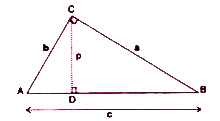ABC is a right traingle, right angled at C. if P is the length of perpendicular from C to AB and AB=c, BC=a and CA=b, then prove that (i) pc=ab (ii) 1p2=1a2+1b2
To solve the problem, we will prove two statements regarding triangle ABC, which is a right triangle with the right angle at C. We will denote the lengths as follows: AB = c, BC = a, and CA = b. The length of the perpendicular from C to AB is denoted as P.
1. Calculate the Area of Triangle ABC:
The area of triangle ABC can be calculated using the base and height. Here, we can take AB as the base and the height from C to AB (which is P).
Area=12×base×height=12×c×P
2. Calculate the Area Using Other Sides:
We can also calculate the area using the other two sides BC and CA, where BC = a and CA = b.
Area=12×a×b
3. Set the Two Area Expressions Equal:
Since both expressions represent the area of the same triangle, we can set them equal to each other:
12×c×P=12×a×b
4. Cancel Out the Common Factor:
We can cancel 12 from both sides:
c⋅P=a⋅b
5. Rearranging Gives Us the Required Result:
Thus, we have:
P⋅c=a⋅b
(ii) Prove that 1p2=1a2+1b2
1. From the First Result:
From the first part, we have:
c=a⋅bP
2. Using Pythagorean Theorem:
According to the Pythagorean theorem, for triangle ABC:
c2=a2+b2
3. Substituting for c:
Substitute c from the first result into the Pythagorean theorem:
(a⋅bP)2=a2+b2
4. Squaring the Left Side:
Expanding the left side gives:
a2⋅b2P2=a2+b2
5. Rearranging:
Rearranging gives:
1P2=a2+b2a2⋅b2
6. Breaking Down the Right Side:
We can separate the right side:
1P2=1a2+1b2
Final Results:
Thus, we have proved both statements:
1. p⋅c=a⋅b
2. 1p2=1a2+1b2
The area of triangle ABC can be calculated using the base and height. Here, we can take AB as the base and the height from C to AB (which is P).
Area=12×base×height=12×c×P
We can also calculate the area using the other two sides BC and CA, where BC = a and CA = b.
Area=12×a×b
Since both expressions represent the area of the same triangle, we can set them equal to each other:
12×c×P=12×a×b
We can cancel 12 from both sides:
c⋅P=a⋅b
Thus, we have:
P⋅c=a⋅b
From the first part, we have:
c=a⋅bP
According to the Pythagorean theorem, for triangle ABC:
c2=a2+b2
Substitute c from the first result into the Pythagorean theorem:
(a⋅bP)2=a2+b2
Expanding the left side gives:
a2⋅b2P2=a2+b2
Rearranging gives:
1P2=a2+b2a2⋅b2
We can separate the right side:
1P2=1a2+1b2
Thus, we have proved both statements:
1. p⋅c=a⋅b
2. 1p2=1a2+1b2
Topper's Solved these Questions
- BOOK - NAGEEN PRAKASHAN ENGLISHCHAPTER - TRIANGLES EXERCISE - Problems From NCERT/ Exemplar14videos
TRIANGLES
- BOOK - NAGEEN PRAKASHAN ENGLISHCHAPTER - TRIANGLES EXERCISE - Exercise 6a24videos
TRIANGLES
- BOOK - NAGEEN PRAKASHAN ENGLISHCHAPTER - STATISTICS EXERCISE - Revision Exercise Long Answer Questions4videos
STATISTICS
- BOOK - NAGEEN PRAKASHAN ENGLISHCHAPTER - VOLUME AND SURFACE AREA OF SOLIDSEXERCISE - Revisions Exercise Long Answer Questions5videos
VOLUME AND SURFACE AREA OF SOLIDS
Similar Questions
ABC is a right triangle right-angled at C . Let BC=a, CA=b, AB=c and let p be the length of perpendicular from C on AB , prove that (i) cp=ab
View SolutionIn a right triangle ABC, right angled at A, AD is drawn perpendicular to BC. Prove that:
AB2−BD2=AC2−CD2View SolutionABC is a isosceles right angled triangle, right angled at C. prove that AB2=2AC2
View SolutionIn triangle ABC, ∠ABC=90∘, AB= c unit, BC= a unit, AC=b unit, CD is perpendicular to AB and CD= p unit.
Prove that : 1p2=1a2+1b2
 View Solution
View SolutionIn △ABC right angled at C. AB= 1.7 cm, BC= 1.5 cm, find CA
View SolutionIn a right triangle ABC, right angled at B . The ratio of AB to AC = 1:√2 , find that the value of 2tanA1+tan2A
View SolutionIf a+b+c=5 and ab+bc+ca=10, then prove that a3+b3+c3−3abc=−25.
View SolutionAB, AC are tangents to a parabola y2=4ax;p1,p2,p3 are the lengths of the perpendiculars from A, B, C on any tangents to the curve, then p2,p1,p3 are in:
View SolutionAB, AC are tangents to a parabola y2=4ax;p1,p2,p3 are the lengths of the perpendiculars from A, B, C on any tangents to the curve, then p2,p1,p3 are in:
View SolutionABC is a triangle right angled at B;and P is the mid-point of AC . Prove that: PQ ⊥AB (ii) Q is the mid point of AB PB=PA=12AC
View Solution

